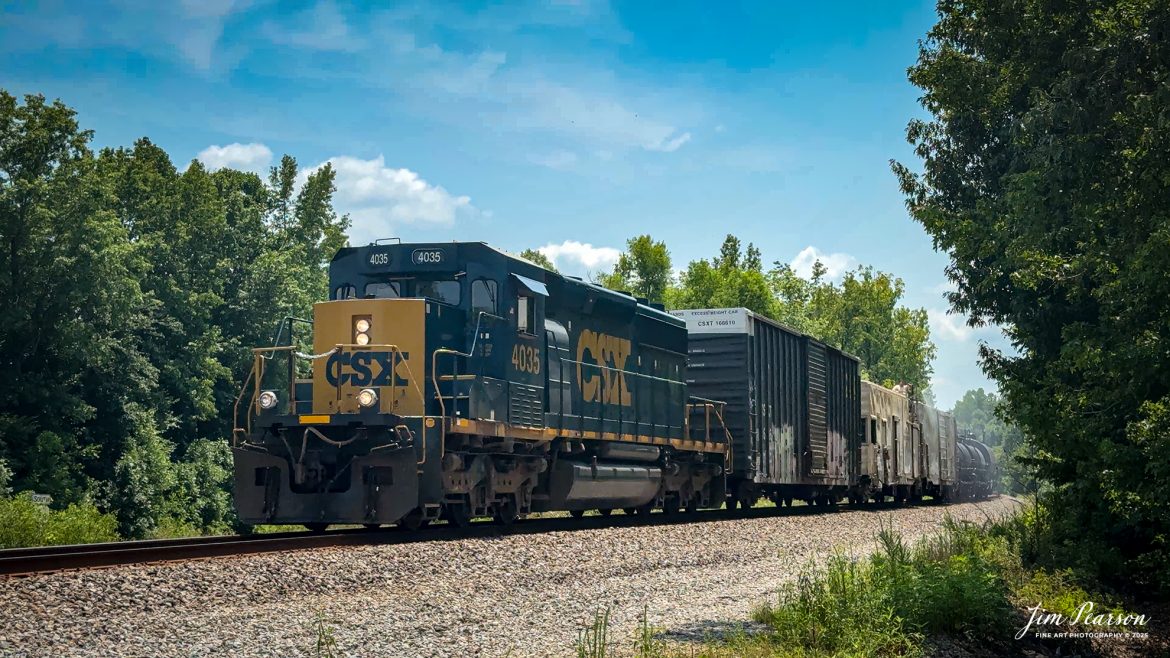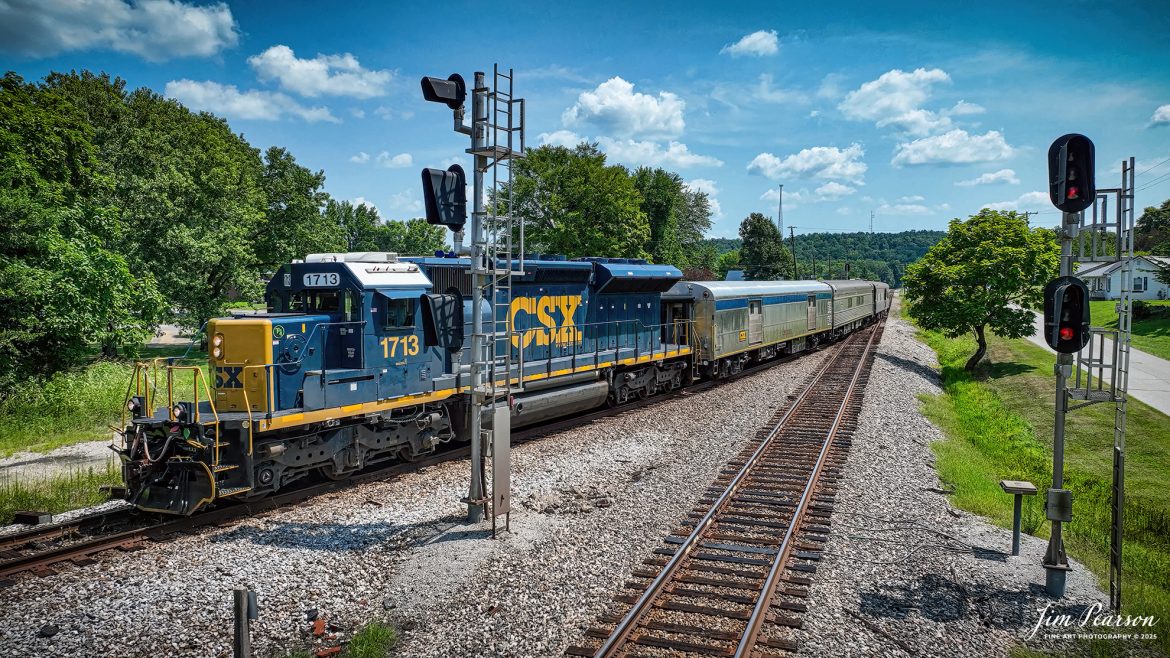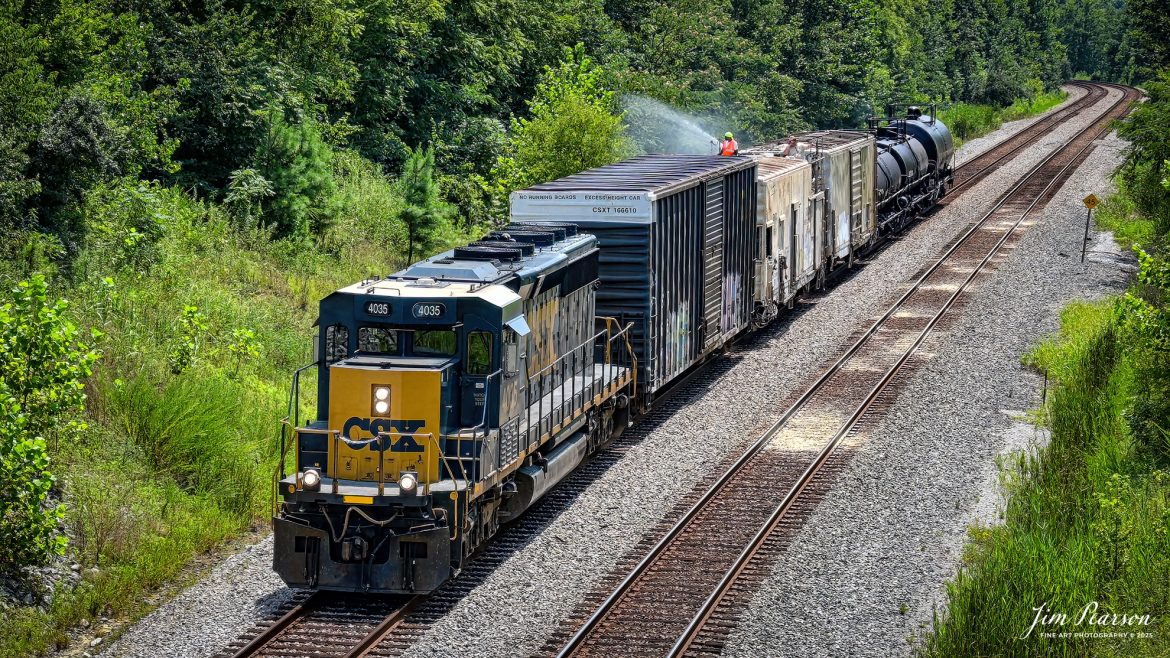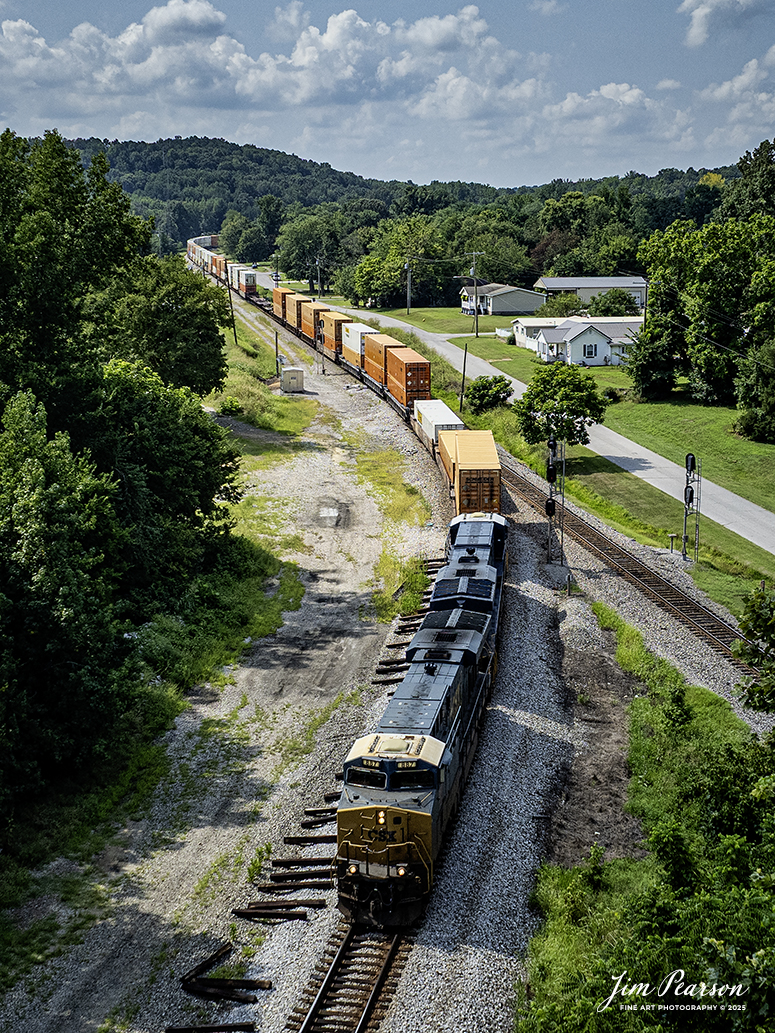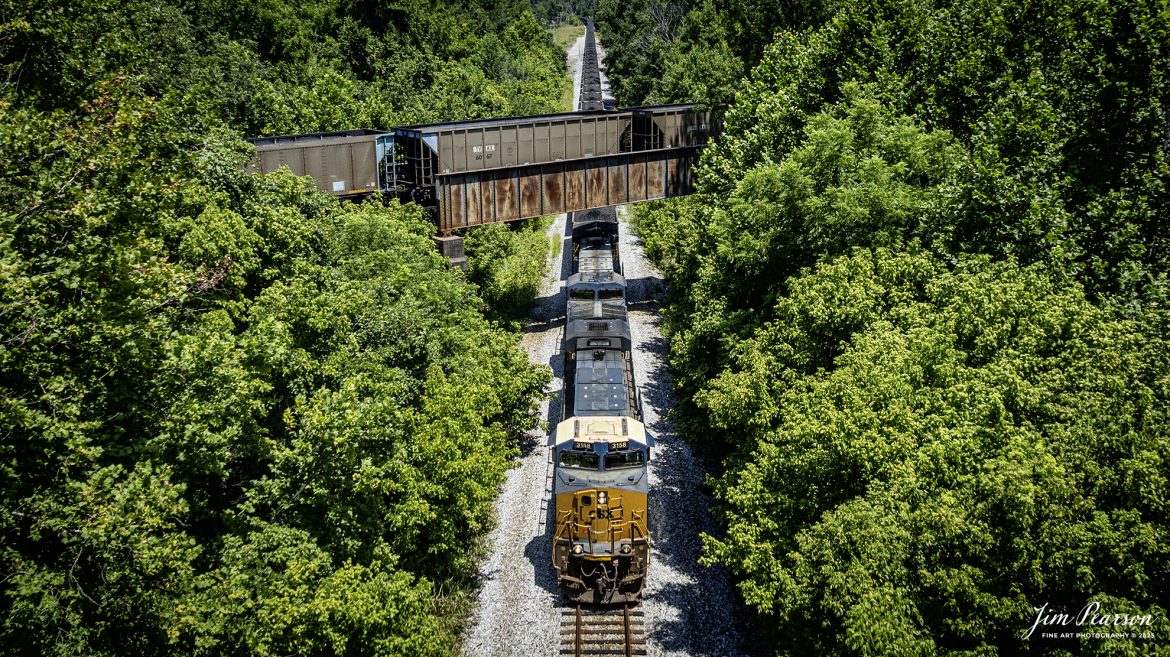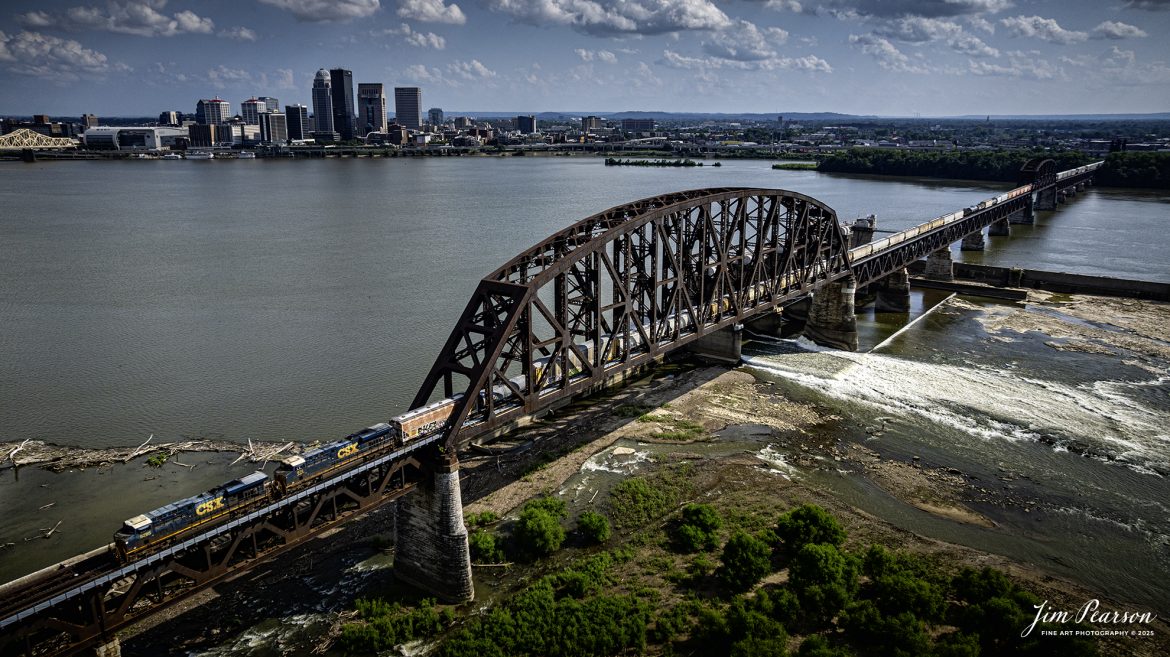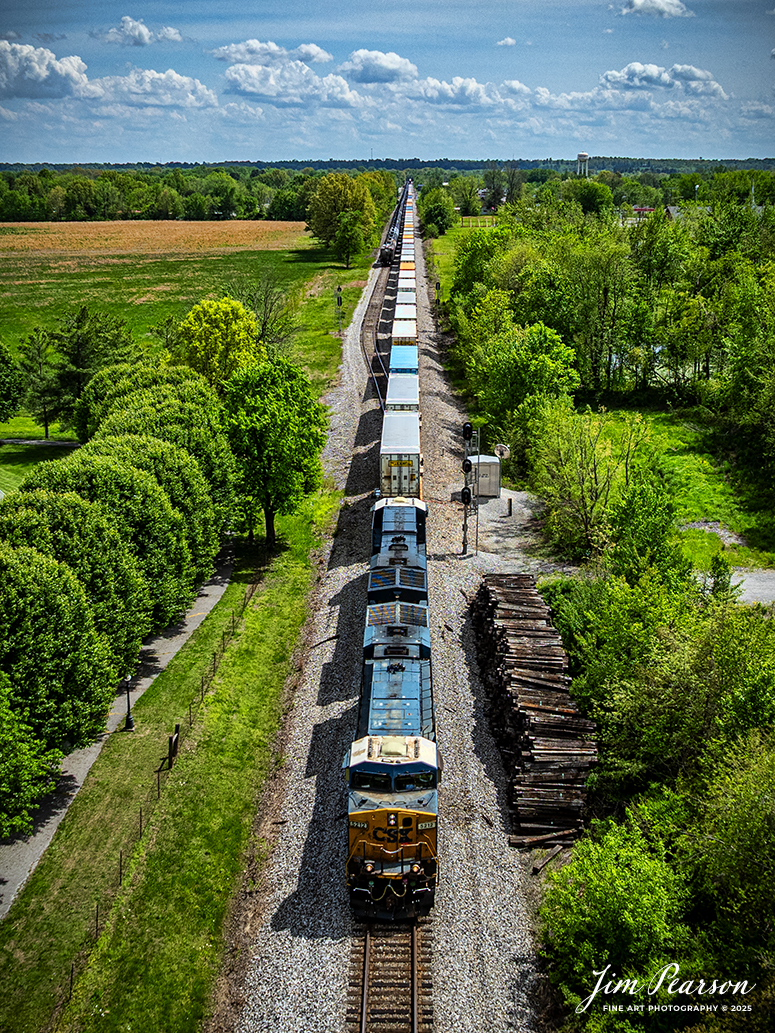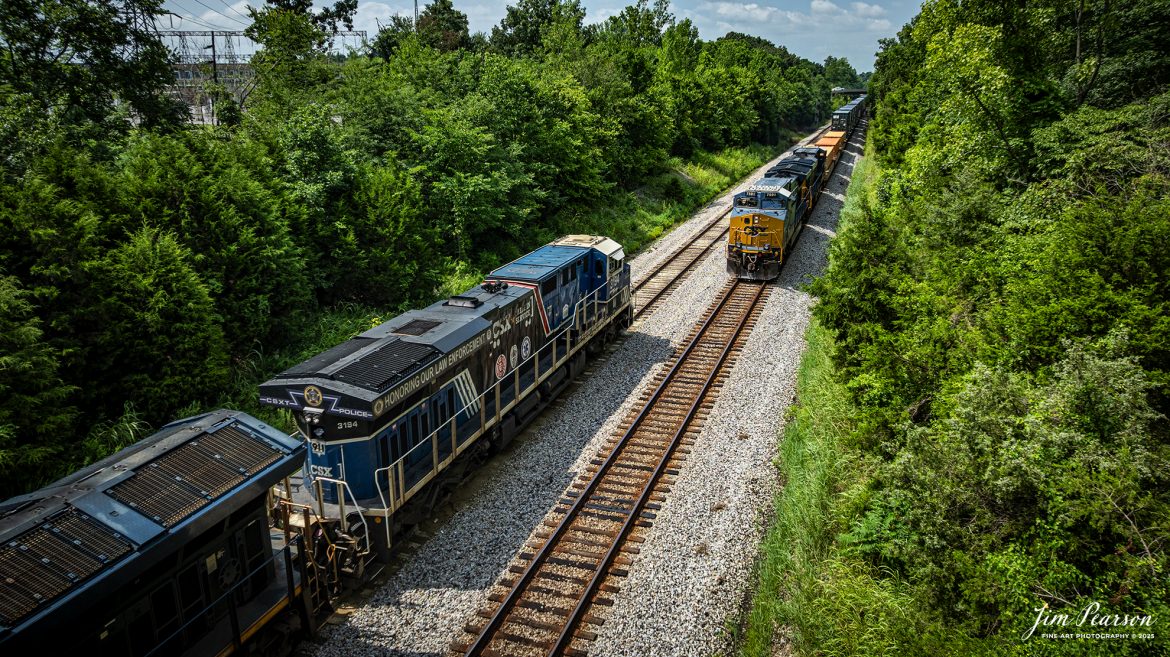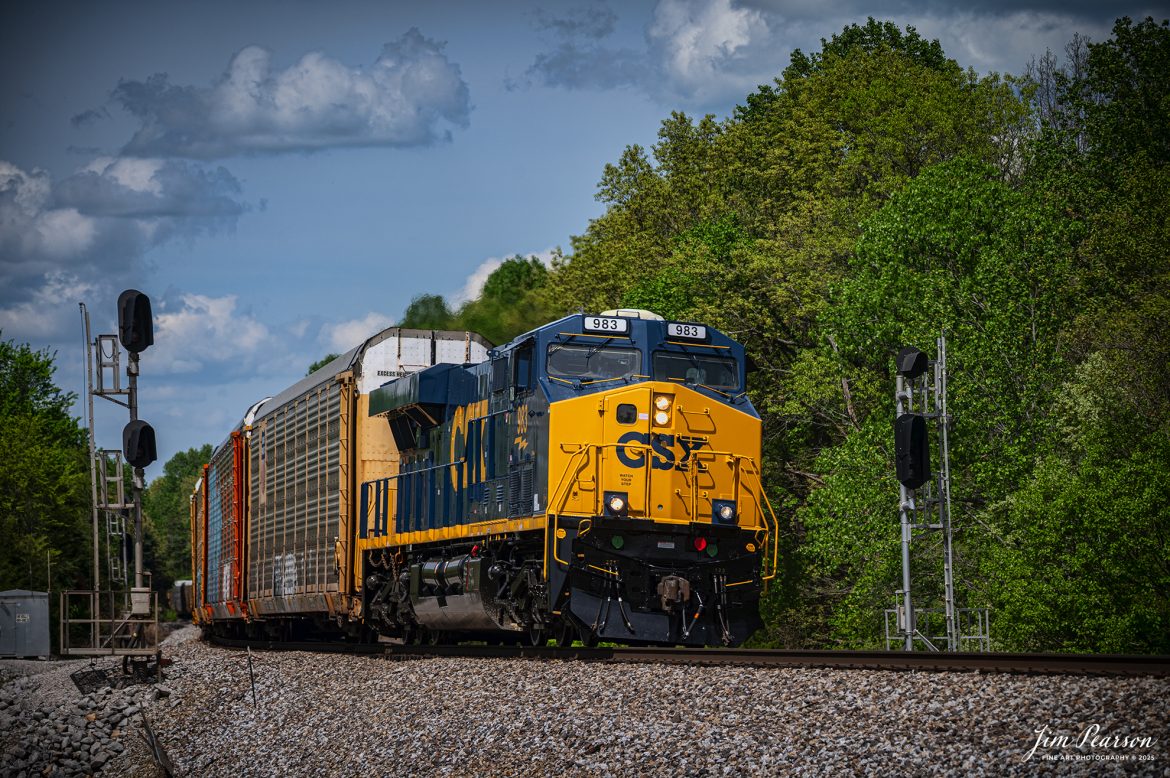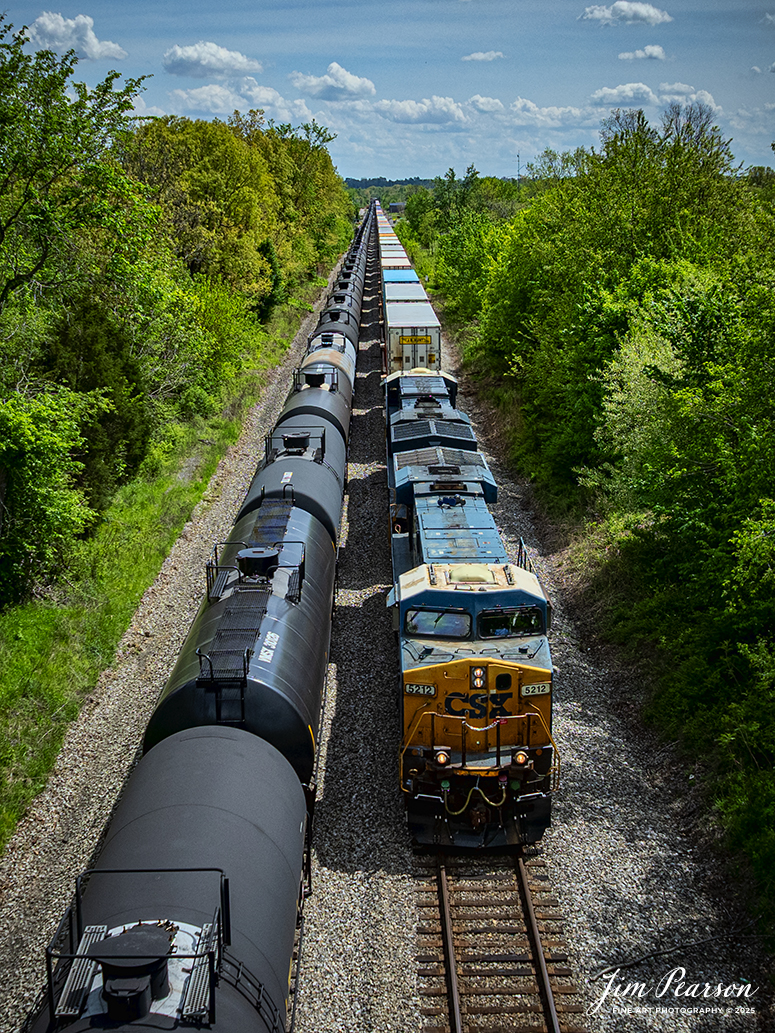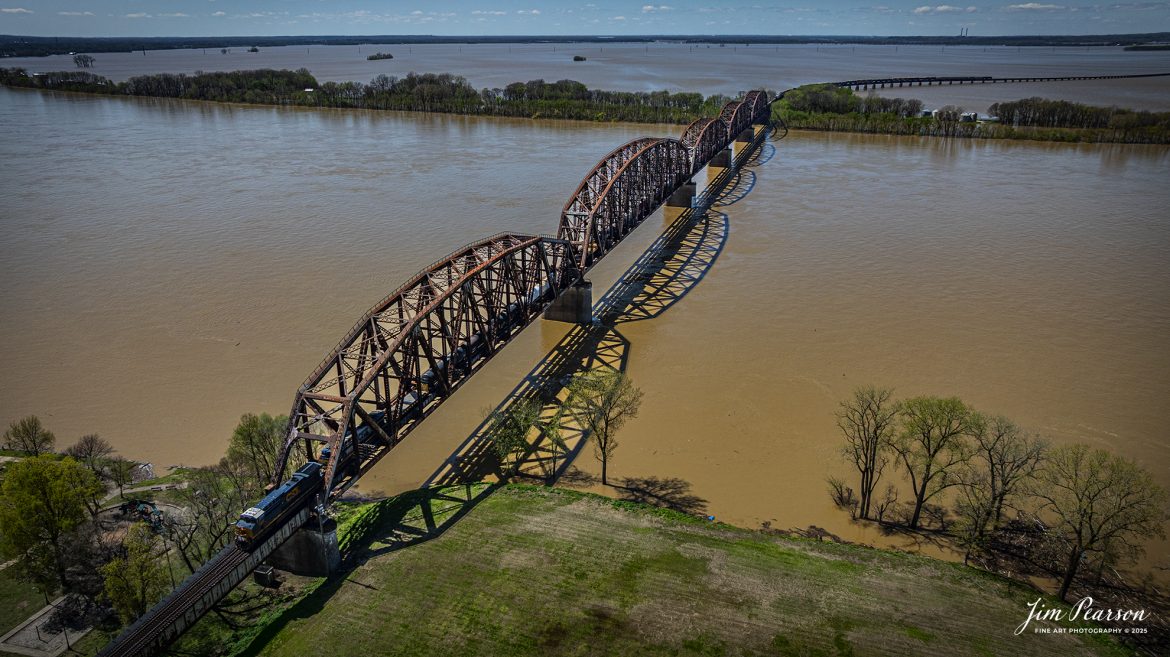August 9th, 2025 – Episode 136 Saturday Edited Video from Jim Pearson Photography In this week’s video we catch trains from the ground and the air between Princeton, IN and Louisville, KY. After spending a day trackside these are the trains I caught on video, and I’ll add a few still shots from other spots throughout this week’s video. Sit back, turn up the sound, expand to full screen and enjoy the trains!! Please like, share, subscribe and thanks for watching!
CSXT 4035 leads weed spraying train W054 as they work their way north at 15mph at Romney, Nortonville, Ky
CSXT 4035 leads weed spraying train W054 as they work their way north at 15mph at Romney, Nortonville, Kentucky, on July 30th, 2025, on the CSX Henderson Subdivision.
According to Wikipedia: A weed sprayer train controls the growth of weeds and other vegetation along railroad rights-of-way that can cause significant issues with drainage, obstruct worker access and become a nuisance to adjacent property owners.
Tech Info: iPhone 16pro Frame Grab from 4K Video.
Paducah and Louisville Railway 35th Anniversary Units, 1986 and 2021 lead the daily local south at Madisonville, Ky
Paducah and Louisville Railway 35th Anniversary Units, 1986 and 2021 lead the daily local south at East Diamond after doing their interchange work with CSX at Atkinson Yard in Madisonville, Ky, on August 2nd, 2025.
The two Paducah & Louisville Railway locomotives were repainted by Progress Rails shops in Mayfield, KY, and numbered to reflect the 35th anniversary of the 280-mile short line, formed from former Illinois Central Gulf lines in 1986.
According to Wikipedia: The Paducah & Louisville Railway is a Class II railroad that operates freight service between Paducah and Louisville, Kentucky. The line is located entirely within the Commonwealth of Kentucky. The 270-mile line was purchased from Illinois Central Gulf Railroad in August 1986.
Tech Info: iPhone 16pro Frame Grab from 4K Video.
A northbound Norfolk Southern Railway empty coal train passes through the countryside at Charleston, Ky
A northbound Norfolk Southern Railway empty coal train passes through the countryside on the Paducah and Louisville Railway at Charleston, Kentucky, on July 29th, 2025, as it heads south past Workman Lake.
Tech Info: DJI Mavic 3 Classic Drone, RAW, 22mm, f/2.8, 1/640, ISO 100
Paducah and Louisville Railway’s University of Louisville locomotive leads coal train north out of Madisonville, Ky
Paducah and Louisville Railway’s University of Louisville locomotive leads the Louisville Gas and Electric loaded coal train north as it passes under the Grapevine Road in Madisonville, Kentucky, on July 30th, 2025.
Tech Info: DJI Mavic 3 Classic Drone, RAW, 22mm, f/2.8, 1/640, ISO 240.
CSXT 1713 leads Geometry train W001 north as they take the cutoff at Mortons Junction at Mortons Gap, Ky
CSXT 1713 leads Geometry train W001 north as they take the cutoff at Mortons Junction at Mortons Gap, Kentucky on July 30th, 2025, on the CSX Henderson Subdivision.
A geometry train pulls equipment to test several parameters of the track geometry. Some of the parameters generally measured include position, curvature, alignment of the track, smoothness, and the crosslevel of the two rails. The cars use a variety of sensors, measuring systems, and data management systems to create a profile of the track being inspected.
Tech Info: This is a 4K video frame grab shot by my DJI Mavic 3 Classic Drone, RAW, 22mm, f/2.8, 1/2000, ISO 100.
CSXT 4035 leads weed spraying train W054 as they work their way north at 15mph at Nortonville, Kentucky
CSXT 4035 leads weed spraying train W054 as they work their way north at 15mph at Nortonville, Kentucky on July 30th, 2025, on the CSX Henderson Subdivision.
According to Wikipedia: A weed sprayer train controls the growth of weeds and other vegetation along railroad right-of-ways that can cause significant issues with drainage, obstruct worker access and become a nuisance to adjacent property owners.
Tech Info: This is a 4K video frame grab shot by my DJI Mavic 3 Classic Drone, RAW, 22mm, f/2.8, 1/2000, ISO 100.
CSX I128 pulls onto the cutoff at Mortons Junction from the main at Mortons Gap, Ky
CSX I128 pulls onto the cutoff at Mortons Junction from the main as it heads north on the CSX Henderson Subdivision on July 30th, 2025. This track bypasses the downtown areas of Earlington and Madisonville, Ky and joins back onto the main at Arklow, just north of Madisonville. This stretch of track allows the dispatcher to run opposing trains around each other.
Tech Info: DJI Mavic 3 Classic Drone, RAW, 22mm, f/2.8, 1/2500, ISO 190.
August 2nd, 2025 – Episode 135 Saturday Edited Video from Jim Pearson Photography
August 2nd, 2025 – Episode 135 Saturday Edited Video from Jim Pearson Photography In this week’s video we catch trains from the ground and the air between Earlington and Kelly, Ky on the CSX Henderson Subdivision. Sit back, turn up the sound, expand to full screen and enjoy the trains!! Please like, share, subscribe and thanks for watching!
Norfolk Southern New York Central Heritage unit 1066 leads NS 278 over the K&I bridge at Louisville, Ky
Norfolk Southern New York Central Heritage unit 1066 leads NS 278 northbound across the 4th Street Diamond at Louisville, Kentucky on July 28th, 2025, on the NS Louisville District, crossing over the CSX Louisville Terminal Subdivision.
Tech Info: 4K Frame Grab from a DJI Mavic 3 Classic Drone, RAW, 22mm, f/2.8, 1/2000, ISO 120.
Norfolk Southern 7762 leads NS 168 westbound over the K&I bridge out of Louisville, Kentucky
Norfolk Southern 7762 leads NS 168 westbound over the Kentucky & Indiana Bridge (K&I bridge) out of Louisville, Kentucky, over the Ohio River into New Albany, Indiana on the NS Louisville District, on July 28th, 2025. From what I can tell the third unit is an ex-BNSF locomotive. In the background is the lock for barge traffic and the city of Louisville, Ky.
According to Wikipedia: The Kentucky & Indiana Bridge is one of the first multi modal bridges to cross the Ohio River. It is for both railway and common roadway purposes together. By federal, state, and local law railway and streetcar, wagon-way, and pedestrian modes of travel were intended by the City of New Albany, City of Louisville, State of Kentucky, State of Indiana, the United States Congress, and the bridge owners.
The K & I Bridge connects Louisville, Kentucky to New Albany, Indiana. Constructed from 1881 to 1885 by the Kentucky and Indiana Bridge Company, the original K&I Bridge opened in 1886. It included a single standard gauge track and two wagon ways, allowing wagons and other animal powered vehicles to cross the Ohio River by a method other than ferry for the first time. At the time motorized vehicles were virtually nonexistent.
The K&I Bridge company also owned a ferry boat operation during both the 1st and 2nd bridge; eventually that operation was sold as the bridge’s success largely outmoded boat usage.
In 1910 the bridge company was renamed the Kentucky & Indiana Terminal Railroad Co. From 1910 to 1912, a new, heavier bridge was built on new piers just upstream from the original one, after which the old bridge was demolished. The new bridge was double tracked to handle increasingly heavier train and now automobile traffic, eventually receiving the U.S. 31W designation.
The bridge also featured a rotating swing span opening for the passage of ships in high water. The bridge was only opened four times, twice for testing in 1913 and 1915, then in 1916 for the passage of the steamer “Tarascon” and in 1920 for passage of the Australian convict ship “Success”. In 1948 it refused opening of the span for passage of the steamer “Gordon C. Greene” citing inconvenience and costs of cutting power and communication lines, an action for which K&I and LG&E both paid damages to that ship’s company. In 1955 the K&I sought and received permission to permanently tie down the swing span from the Corps of Engineers. In 1952, the creosoted wood block roadways of the second bridge were eliminated and replaced by a steel gridwork roadway.
On February 1, 1979, an overweight dump truck caused a small segment of the steel grate roadway on the bridge to sag about 1 foot (0.30 m). A quick survey promised to reopen the roadway, but automotive traffic was banned thereafter by the railroad.
Tech Info: DJI Mavic 3 Classic Drone, RAW, 22mm, f/2.8, 1/1600, ISO 130.
CSX loaded coal train, C306, passes under a SB NS train at Monarch, Madisonville, Ky
On the track above we see an empty Norfolk Southern southbound coal train on the Paducah and Louisville Railway at the location known as Monarch at Madisonville, Ky as a southbound CSX loaded coal train, C306, passes under them, on July 29th, 2025, on the CSX Henderson Subdivision. It would have been great if the CSX had got there about 45 seconds sooner or the NS train the same later so I could have caught the power from both trains in one shot, but I’ll take it how I can get it!!
I’ve been trying for some time to get trains on both tracks and while I would like for it to be the headend power on both tracks, it would be a Miracle, but I plan to keep trying!
Tech Info: DJI Mavic 3 Classic Drone, RAW, 22mm, f/2.8, 1/2000, ISO 120.
Norfolk Southern 4378 leads a southbound empty coal train at the location known as Monarch at Madisonville, Ky
Norfolk Southern 4378 leads a southbound empty coal train on the Paducah and Louisville Railway at the location known as Monarch at Madisonville, Ky as a southbound CSX loaded coal train, C306, approaches, on July 29th, 2025, on the CSX Henderson Subdivision. It would have been great if the CSX had got there about 45 seconds sooner or the NS train the same later, but I’ll take it how I can get it!!
I’ve been trying for some time to get trains on both tracks and while I would like for it to be the headend power on both tracks, it would be a Miracle! Watch for tomorrow afternoon’s picture of CSX 306 passing under this NS train!
Tech Info: DJI Mavic 3 Classic Drone, RAW, 22mm, f/2.8, 1/1600, ISO 110.
CSX M688 heads north across the Ohio River on the 14th Street Bridge at Louisville, Ky
CSX M688 heads north across the Ohio River on the 14th Street Bridge (Louisville and Indiana (L&I) Bridge) at Louisville, Ky on July 28th, 2025. This bridge carries traffic for the Louisville and Indiana, along with the CSX Railroad. In the background is downtown Louisville, Ky.
According to Wikipedia: The Fourteenth Street Bridge, also known as the Ohio Falls Bridge, Pennsylvania Railroad Bridge, Conrail Railroad Bridge or Louisville and Indiana (L&I) Bridge, is a truss drawbridge that spans the Ohio River, between Louisville, Kentucky and Clarksville, Indiana.
Built by the Louisville Bridge Company and completed in 1870, the bridge was operated for many years by the Pennsylvania Railroad, giving the company its only access to Kentucky. Ownership of the railroad and the bridge passed on to Penn Central and later Conrail, which then sold the line from Louisville to Indianapolis, Indiana to the Louisville and Indiana Railroad, the current bridge owner.
The draw portion of the bridge is a vertical-lift span, built in about 1918 in place of a swing span. The towers and machinery of the lift span were designed by Waddell and Son, Inc., and there is a plaque on the SW tower reading, “Waddell Vertical Lift Bridge, Waddell and Son, 1917”. The draw span is across the upstream end of the Louisville and Portland Canal, which includes the McAlpine Locks and Dam. Ohio River traffic passes through this canal to navigate past the Falls of the Ohio.
Tech Info: DJI Mavic 3 Classic Drone, RAW, 22mm, f/2.8, 1/2500, ISO 110.
CSX northbound intermodal I128 passes B621 at Crofton, Ky
CSX northbound intermodal I128 passes B621, a loaded ethanol train, as they wait in the siding at Crofton, Kentucky, on the CSX Henderson Subdivision, on April 23, 2025.
Tech Info: DJI Mavic 3 Classic Drone, RAW, 24mm, f/2.8, 1/3200, ISO 110.
CSX I025 waits in the siding at Kelly, Ky for I128 to pass
CSX I025 waits in the siding at Kelly, Ky with CSXT 3194 Law Enforcement Unit leading the way, on July 22nd, 2025, on the CSX Henderson Subdivision, as they wait for I128 NB to pass.
From a CSXT Press Release: CSXT 3194 is being renamed to honor our nation’s police officers who dedicate their lives to serve and protect communities across our network.
“CSX is proud of the employee craftsmanship involved in transforming this locomotive into a special commemorative engine,” says Ed Harris, executive vice president of operations. “This is a moving tribute to the men and women who serve us every day and aligns with CSX’s goal to connect military service members, first responders, and their families to the resources and support they need.”
The Spirit of our Law Enforcement joins our collection of Pride in Service locomotives launched this spring – the Spirit of our Armed Forces and the Spirit of our First Responders. When not actively moving customers – freight, the locomotives are made available for special events along the CSX system – extending our culture of service and commitment from our customers to the communities where we operate.
Tech Info: DJI Mavic 3 Classic Drone, RAW, 22mm, f/2.8, 1/1600, ISO 130.
CSXT 983 leads autorack train M217 south at Robards, Ky
A newly painted and refurbished CSXT 983 leads autorack train M217 south as it passed the signals at the north end of the siding at Kelly, Kentucky on April 23rd, 2025, on the CSX Henderson Subdivision.
Tech Info: Nikon Z6ii, RAW, Nikon 70-300 @ 150mm, f/6.3, 1/1250, ISO 250.
CSXT 3118 leads B621, a loaded ethanol train, as they wait in the siding at Crofton, Kentucky
CSXT 3118 leads B621, a loaded ethanol train, as they wait in the siding at Crofton, Kentucky, as they wait for northbound intermodal I128 to pass them, on the CSX Henderson Subdivision, on April 23, 2025.
Tech Info: DJI Mavic 3 Classic Drone, RAW, 24mm, f/2.8, 1/3200, ISO 140.
July 26th, 2025 – Episode 134Saturday Edited Video from Jim Pearson Photography
In this week’s video we catch trains from the ground and the air between Robards and Hopkinsville, Ky on the CSX Henderson Subdivision, including CSXT GMS-2 inspecting track between Hopkinsville and Nortonville, Ky. Sit back, turn up the sound, expand to full screen and enjoy the trains!! Please like, share, subscribe and thanks for watching!
CSX B231, led by a mashup of Canadian National and Norfolk Southern power, heads north from Madisonville, Ky
CSX B231, led by a mashup of Canadian National and Norfolk Southern power, heads north at the location known as Arklow at Madisonville, Kentucky on the CSX Henderson Subdivision, on April 17th, 2025. This is where the cutoff track that runs from Mortons Gap to Madisonville, Ky by-passes the downtown areas.
Tech Info: DJI Mavic 3 Classic Drone, RAW, 24mm, f/2.8, 1/800, ISO 410.
CSX M513 heads south over the flooded Ohio River at Henderson, Kentucky
CSX M513 heads south over the flooded Ohio River at Henderson, Kentucky on April 8th, 2025, on the CSX Henderson Subdivision.
This area of Kentucky and southern Indiana got record breaking rainfall throughout the region over a three-day period which resulted in major flooding on both sides of the Ohio River. In the distance you can see the farmlands which have been totally covered by the flooding and the ballast deck out of Evansville was close to being covered, but fortunately it didn’t happen.
Tech Info: DJI Mavic 3 Classic Drone, RAW, 22mm, f/2.8, 1/2000, ISO 100.

